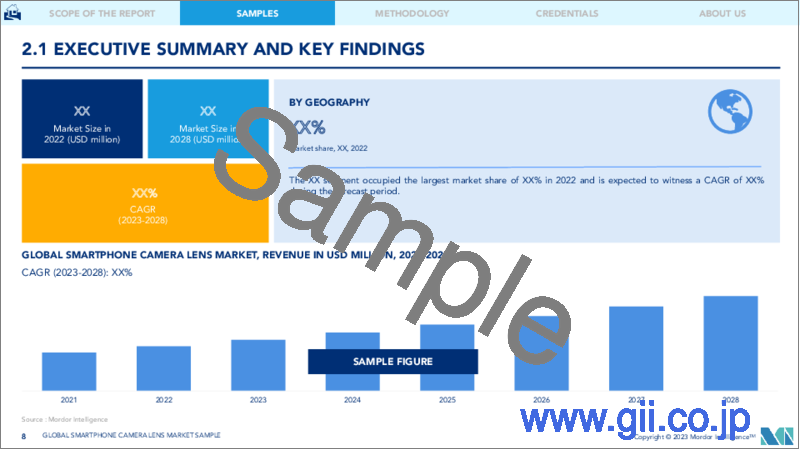|
|
市場調査レポート
商品コード
1198392
スマートフォン用カメラレンズ市場- 成長、動向、予測(2023年~2028年)Smartphone Camera Lens Market - Growth, Trends, and Forecasts (2023 - 2028) |
||||||
|
● お客様のご希望に応じて、既存データの加工や未掲載情報(例:国別セグメント)の追加などの対応が可能です。 詳細はお問い合わせください。 |
|||||||
| スマートフォン用カメラレンズ市場- 成長、動向、予測(2023年~2028年) |
|
出版日: 2023年01月23日
発行: Mordor Intelligence
ページ情報: 英文 120 Pages
納期: 2~3営業日
|
- 全表示
- 概要
- 目次
スマートフォン用カメラレンズ市場は、予測期間中にCAGR8%で成長すると予想されます。
スマートフォンメーカー各社が安定した売上を記録しており、市場の需要は急増しています。しかし、歴史的にサプライチェーンに制約のある需要曲線と同様に、現在の市場シナリオは需給の不均衡を示しており、調査対象市場の全体的な成長ポテンシャルを制限しています。
主なハイライト
- スマートフォンメーカーは、より高い製品差別化を実現するためにカメラの品質にこだわり始めています。最新のスマートフォンに搭載されるカメラは、消費者の要求と、単体カメラからスマートフォンのカメラへの動向の変化により、猛烈なスピードで進化しています。高度なカメラシステムを搭載した最新のスマートフォンのイントロダクションは、市場を推進することが予想されます。例えば、2022年9月にApple Inc.が発表したiPhone 14とiPhone 14 Plusは、前面と背面の新しいTrueDepthカメラ、独自のアングルを実現するウルトラワイドカメラ、フォトニックエンジンを含む強力なカメラシステムを特徴としています。
- 世界のスマートフォンの大増殖により、カメラの品質へのこだわりや、より高い製品差別化の達成のために、これらのスマートフォン向けのカメラレンズの膨大な需要が見込まれます。スマートフォンに搭載されるカメラは、消費者の高画質化要求や、単体カメラからスマートフォン用カメラへの移行が進んでいることから、急速な進化を遂げつつあります。
- さらに、InstagramやSnapchatなどのソーシャルメディアユーザーが、商品撮影やポートレート撮影など最新の動向と歩調を合わせたいという要望の高まりや、ソーシャルメディアのインフルエンサーの急増が、口径の広いレンズの採用を後押ししています。これも市場の成長に大きな影響を与えています。
- また、デュアルカメラや複数のカメラを搭載する傾向も強まっています。これはスマートフォンの新しい技術で、デザイン性をあまり犠牲にすることなくセカンダリーカメラを追加することで実現されており、良い兆候であると言えます。今後、デュアルカメラへの需要は明るいと思います。デュアルレンズカメラは、それぞれのレンズの焦点距離を変えることで、ズーム機能を向上させることもできます。
- 革新的な機能と価格の低下が、スマートフォン用カメラレンズ市場をさらに推進すると予想されます。中国、日本、インドなど一部の国では、低価格でシステムが利用できることと、堅調な経済成長が、アジア太平洋地域のスマートフォン用カメラレンズ市場に大きな機会を提供すると思われます。このように、スマートフォン需要の伸びは、スマートフォン用カメラレンズ業界の消費に直接影響を及ぼしています。
- 現在進行中のCOVID-19の大流行により、市場はサプライチェーンにかなりの混乱を示しました。スマートフォン用カメラレンズの需要は、一部の地域のスマートフォン販売台数の急減に伴い減少しました。例えば、インドでは、2021年のCOVID-19の第2波の際に、スマートフォンの販売台数が大幅に減少しました。
スマートフォン用カメラレンズの市場動向
先進的なカメラ技術の導入が市場を牽引
- スマートフォンの薄型化の要求が常に高まる中、デバイスの設計者は、スマホの高さと幅の大きさを利用して、スマホに増加したカメラを内蔵し、スマホに複数のカメラレンズの市場を作り出しました。
- スマートフォン用カメラレンズは、スマートフォンを持つことが贅沢ではなく、必需品となったライフスタイルの変化により、大きな需要があります。また、可処分所得の増加に伴い、写真などの趣味を持つ消費者が購入する可能性が高まっています。その結果、カメラレンズが充実したハイエンドスマートフォンの普及が進む可能性があります。
- スマートフォンは、手ぶれ補正、デジタルカメラ用プロセッサの高速化、ストレージデバイスの大幅な容量増加と高速化などの技術進化により、急速に販売台数が増加しました。例えば、エリクソン社によると、2026年には全世界のスマートフォン契約台数は75億1,600万台に達すると予想されています。
- スマートフォンの技術革新の重要な方向性のひとつは、引き続き光学系です。テレズーム、ナイトモード、超広角、高画質などの機能向上により、カメラの安定性、厚さ、光学解像度など、より厳しい基準が設定されています。
- 光学レンズ産業は、スマートフォンのカメラ数の構造的な増加や、高い技術力と資本集約度による大きな参入障壁を考慮すると、他の部品サブセクターと比較して有利な立場にあると言えるでしょう。
アジア太平洋地域が大幅な成長を遂げるだろう
- エンドユーザーからの需要の高まりは、コンパクトカメラ用部品への投資と能力強化の動機付けとなっています。例えば、Xiaomiの部品サプライヤーであるHolitech Technologyは、2019-2022年にインドに2億米ドルを投資し、Xiaomiに販売される可能性のあるコンパクトカメラ部品や静電容量式タッチパネルモジュール(CTP)などを製造する計画でした。
- モバイル加入者の増加も、地域市場の成長に寄与しています。GSMAによると、2025年までにアジア太平洋地域は全世界の新規顧客の半分以上を占めるようになります。それまでに、この地域全体でさらに2億6600万人の携帯電話加入者がつながり、30億人以上に増加すると予想されます。
- 中国のファーウェイは、デュアルカメラ技術により、撮影後にピントを合わせ直すことができるアンドロイドスマートフォンを発売しました。この機能は、中国のハイテク企業とドイツのカメラメーカーであるライカとのコラボレーションによって実装されています。
- アジア太平洋地域の大多数のスマートフォン・メーカーが高いカメラ品質を持つスマートフォンを発売していることも、市場のイノベーションを後押ししています。例えば、2022年4月にXiaomiがインドで発売したスマートフォン「12 Pro」は、5000万画素の超広角センサー、OISを持つ5000万画素のメインセンサー、5000万画素の望遠センサーからなるトリプルリアカメラ配置が特徴でした。前面には3200万画素のカメラを搭載し、動画や自撮り、ビデオ通話に対応しています。
スマートフォン用カメラレンズ市場の競合他社分析
スマートフォン用カメラレンズ市場の競争は緩やかです。大小多くのプレイヤーが存在するため、軽度に集中し、断片化した段階へと移行しているように見えます。主要な市場プレーヤーには、Ability Opto-Electronics Technology、AAC Technologies、Cowell Optics、IM、Kantatsuなどがあります。これらの企業は、市場シェアを維持するために技術革新を続け、戦略的パートナーシップを結んでいます。
2022年4月、コーシアオプティクスは、導入されたギャラクシーS22シリーズを始めとするギャラクシーSスマートフォンシリーズに使用するレンズモジュールをサムスンに提供すると発表しました。このレンズモジュールは、Galaxy Sスマートフォンシリーズのフェイスカメラに使用されます。
2021年4月、ファーウェイはP50 Proの発売とともに、メインの5000万画素フルカラーセンサーと併用することで画像ノイズを減らし、ディテールを強調する4000万画素モノクロ専用センサーを配備しました。
その他の特典
- エクセル形式の市場予測(ME)シート
- アナリストによる3ヶ月間のサポート
目次
第1章 イントロダクション
- 調査の前提条件と市場の定義
- 調査対象範囲
第2章 調査手法
第3章 エグゼクティブサマリー
第4章 市場力学
- 市場概要
- 産業の魅力- ポーターのファイブフォース分析
- 買い手の交渉力
- 供給企業の交渉力
- 新規参入業者の脅威
- 代替品の脅威
- 競争企業間の敵対関係
- COVID-19がスマートフォン用カメラレンズ市場に与える影響
- 市場促進要因
- マルチカメラアプローチの進化と先端カメラ技術のイントロダクション
- 市場の課題
- スマートフォンの販売減速と価格競争の激化
第5章 市場セグメンテーション
- 地域別
- アジア太平洋地域
- 南北アメリカ
- 欧州
第6章 ベンダーランキング分析
第7章 競合情勢
- 企業プロファイル
- Ability Opto-Electronics Technology Co. Ltd
- AAC Technologies
- Cowell Optics
- IM Co. Ltd
- Kantatsu Co. Ltd
- SEKONIX Co. Ltd
- Genius Electronic Optical(GSEO)
- Sunny Optical Technology Company Limited
- Largan Precision Company Limited
- Union Optech(Zhongshan)Co. Ltd
- Kinko Optical Co. Ltd
- Haesung Optics
第8章 投資分析および機会
The smartphone camera lens market is expected to register a CAGR of 8% during the forecast period. The market demand is surging, with stable sales registered by several smartphone manufacturers. However, similar to the historically undulating demand curve with supply chain restrictions, the current market scenario indicates a demand-supply in-equilibrium that delimits the overall growth potential of the market studied.
Key Highlights
- Smartphone manufacturers have started focusing on the quality of their cameras to achieve higher product differentiation. The cameras in the latest smartphones are evolving at a breakneck pace, owing to the demand of consumers and a shift in trend from using standalone cameras to smartphone cameras. The introduction of the latest smartphones with advanced camera systems is expected to propel the market. For instance, in September 2022, Apple Inc. introduced iPhone 14 and iPhone 14 Plus, featuring a strong camera system that includes new TrueDepth cameras on the front and back, an Ultra Wide camera for unique angles, and a Photonic Engine.
- The massive growth in smartphones worldwide is expected to create massive demand for camera lenses for these smartphones due to the growing focus on the quality of their cameras and achieving higher product differentiation. The cameras in smartphones are evolving at a rapid pace, owing to the demand from consumers for better picture quality and a gradual shift in trend from using standalone cameras to smartphone cameras.
- Moreover, the growing demand for social media users to keep par with the latest trends, like Instagram and Snapchat, with product photography or portrait photography, coupled with a massive growth of social media influencers are augmenting the adoption of a lens with a wider aperture. This also made a significant impact on the growth of the market.
- There is also an increasing trend for dual-camera or multiple cameras. This is a new technology for smartphones, which is attained by adding a secondary camera without sacrificing much in the way of design is a good sign. In the future, the demand for dual-camera systems will be bright. A dual-lens camera may also improve zoom capability by having a different focal length on each lens.
- Innovative features and a decline in prices are expected to further propel the smartphone camera lens market. The availability of systems at a low price and robust economic growth in some countries, such as China, Japan, and India, is likely to offer significant opportunities to the smartphone camera lens market in the Asia-Pacific. Thus, the growth in smartphone demand is directly impacting the consumption of the smartphone camera lens industry.
- Due to the ongoing COVID-19 pandemic, the market witnessed considerable disruptions in the supply chain. The demand for smartphone camera lenses decreased with a steep nosedive in smartphone sales in a few regions. For instance, in India, the sales of smartphones dropped considerably during the second COVID-19 wave in 2021.
Smartphone Camera Lens Market Trends
Introduction of Advanced Camera Technologies to Drive the Market
- With the constant increase in demand for a slimmer smartphone, the designers of the devices have made use of the larger height and width of phones by building the increased number of cameras in the phone, creating a market for multiple camera lenses in the smartphone.
- Smartphone camera lenses remain in great demand due to a shift in people's lifestyles in which possessing a smartphone is no longer a luxury but a necessity. Increasing disposable income raises the likelihood of consumers purchasing hobbies like photography. This may result in increased adoption of high-end smartphones with better camera lenses.
- The sale of smartphones increased rapidly due to evolving technology, such as image stabilization, faster processors for digital cameras, and a significant increase in storage devices capacity and improved speed. For instance, according to Ericsson, worldwide smartphone subscription is expected to reach 7,516 million units by 2026.
- One of the key direction for smartphone innovations continue to be optics. The upgrade in tele-zoom, night mode, ultra-wide-angle, and high image resolution features have set more demanding standards for camera stability, height thickness, and optical resolution.
- The optical lens industry is better-placed relative to other component sub-sectors in light of the structural growth of the number of cameras in smartphones and significant entry barriers created by high technological capabilities and capital intensity.
Asia-Pacific to Witness Significant Growth
- The increasing demand from end-user manufacturers motivates market suppliers to enhance their investment and capabilities for compact camera components. For instance, Holitech Technology, a component supplier of Xiaomi, planned to invest USD 200 million from 2019-2022 in India to manufacture compact camera components, capacitive touch screen modules (CTP), etc., which may be sold to Xiaomi.
- The growing mobile subscribers have also contributed to the regional market's growth. According to GSMA, by 2025, Asia-Pacific will represent over half of all new customers worldwide; by then, it is expected that 266 million additional mobile subscribers to be linked across the region, increasing the number to over 3 billion.
- Huawei, a China-based company, launched an Android smartphone that uses dual-camera technology to let owners refocus photos after they have been taken. The feature is being implemented by the collaboration between the Chinese tech firm and German camera maker Leica.
- The majority of smartphone manufacturers in the Asia-Pacific region launching smartphones with high camera quality are also driving innovation in the market. For example, in April 2022, Xiaomi launched the 12 Pro smartphone in India, featuring a triple rear camera arrangement consisting of a 50-megapixel ultra-wide-angle sensor, a 50-megapixel main sensor having OIS, and a 50-megapixel telephoto sensor. The smartphone boasts a 32-megapixel camera on the front for videos, selfies, and video calls.
Smartphone Camera Lens Market Competitor Analysis
The smartphone camera lens market is moderately competitive. It appears to be mildly concentrated, moving toward the fragmented stage due to the presence of many large and small players in the market. Some of the major market players include Ability Opto-Electronics Technology Co. Ltd., AAC Technologies, Cowell Optics, IM Co. Ltd., and Kantatsu Co. Ltd., among others. These companies keep innovating and entering into strategic partnerships to retain their market share.
April 2022, Coasia Optics announced the provision of a lens module to Samsung for usage on the Galaxy S smartphone series, beginning with the introduced Galaxy S22 series. The lens module would be utilized for the face camera on the Galaxy S smartphone series.
April 2021, with the launch of the P50 Pro, Huawei deployed a 40-megapixel monochrome-only sensor that reduces image noise and enhances detail when used in conjunction with the main 50-megapixel full-color sensor.
Additional Benefits:
- The market estimate (ME) sheet in Excel format
- 3 months of analyst support
TABLE OF CONTENTS
1 INTRODUCTION
- 1.1 Study Assumptions and Market Definition
- 1.2 Scope of the Study
2 RESEARCH METHODOLOGY
3 EXECUTIVE SUMMARY
4 MARKET DYNAMICS
- 4.1 Market Overview
- 4.2 Industry Attractiveness - Porter's Five Forces Analysis
- 4.2.1 Bargaining Power of Buyers
- 4.2.2 Bargaining Power of Suppliers
- 4.2.3 Threat of New Entrants
- 4.2.4 Threat of Substitute Products
- 4.2.5 Intensity of Competitive Rivalry
- 4.3 Impact of COVID-19 on the Smartphone Camera Lens Market
- 4.4 Market Drivers
- 4.4.1 Evolution of Multiple Camera Approaches and Introduction of Advanced Camera Technologies
- 4.5 Market Challenges
- 4.5.1 Slow Down of Smartphone Sales and Increasing Pricing Competition
5 MARKET SEGMENTATION
- 5.1 By Geography
- 5.1.1 Asia-Pacific
- 5.1.2 Americas
- 5.1.3 Europe
6 VENDOR RANKING ANALYSIS
7 COMPETITIVE LANDSCAPE
- 7.1 Company Profiles
- 7.1.1 Ability Opto-Electronics Technology Co. Ltd
- 7.1.2 AAC Technologies
- 7.1.3 Cowell Optics
- 7.1.4 IM Co. Ltd
- 7.1.5 Kantatsu Co. Ltd
- 7.1.6 SEKONIX Co. Ltd
- 7.1.7 Genius Electronic Optical (GSEO)
- 7.1.8 Sunny Optical Technology Company Limited
- 7.1.9 Largan Precision Company Limited
- 7.1.10 Union Optech (Zhongshan) Co. Ltd
- 7.1.11 Kinko Optical Co. Ltd
- 7.1.12 Haesung Optics




